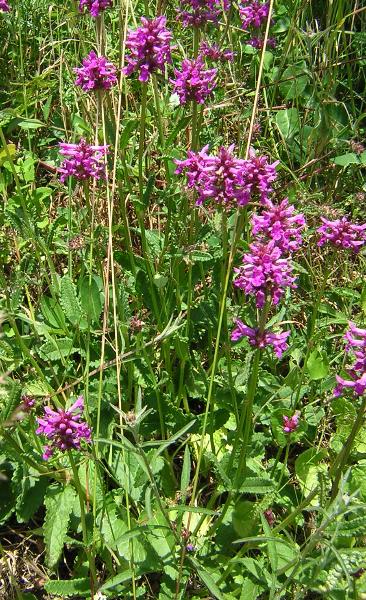- Stachys officinalis
Taxobox | name = "Stachys officinalis"

image_width = 180px
regnum =Plant ae
divisio = Magnoliophyta
classis =Magnoliopsida
ordo =Lamiales
familia =Lamiaceae
genus = "Stachys "
species = "S. officinalis"
binomial = "Stachys officinalis"
binomial_authority = L."Stachys officinalis", commonly known as Purple
betony , Wood betony or Bishop's wort, is a perennialgrassland herb growing to 70cm tall. Its leaves are stalked on upright stems, narrowly oval, with a heart-shaped base, with a somewhat wrinkled texture and toothed margins. The calyx is 5-7mm long, with 5 teeth, edged with bristles. The corolla 1-1.5cm long. Its upper lip flat, almost straight when seen from the side. Theanther s stick straight out. It flowers in mid summer from July to September, and is found in drygrassland ,meadow s and open woods in most ofEurope , westernAsia andNorth Africa . In theBritish Isles it is common inEngland and Wales , but rare inIreland and northernScotland .In folklore
The name "betony" is alleged to derive from the Celtic word "bewton" ("good for the head"). The first reference to it occurs in a work by the Roman physician
Antonius Musa , who claimed it as effective againstsorcery . Later it was claimed to be effective against snake and dog bites, and against drunkenness. It was planted inchurchyard s to prevent activity byghost s.Nicholas Culpeper states that, astrologically, betony is ruled byJupiter and Aries.Herbal medicine
Modern herbalists prescribe betony to treat
anxiety ,gallstone s,heartburn , highblood pressure ,Migraine andNeuralgia , and to preventsweat ing. It can also be used as anointment for cuts and sores. Not all of these uses are supported by scientific evidence.References
*Howard, Michael. "Traditional Folk Remedies" (century 1987), p104.
*Lippert, W. & Podlech, D. "Wildflowers of Britain & Europe". Collins Nature Guides 1994.
Wikimedia Foundation. 2010.
